How Come we Went to the Philippines?
For some years Sally & I had daydreamed about going overseas for a while with the family. We had traveled a lot during our first years of marriage. First to Hancock, then off to Iowa, and an almost to Seattle. Taking a job in western New York brought us back closer to our beginnings. The job gave us the opportunity to travel twice to Boston. First in 1951 to work at MIT in the DACL and find out how an autopilot is designed. Then in 1954 went to study for a year at MIT having been granted a fellowship by Bell Aircraft Corporation. Lionel Shub and I were each given a grant. Upon our return I at one time talked with Dr. Schone at Bell, he declared I should go back to school to get a PhD. Sally and I heartily agreed with this idea and shortly after that I gave my notice to Bell. In September 1956 joined SU as an Instructor, after turning down an offer from the University of Michigan.
After getting my PhD in 1958 I was promoted to Assistant Professor, and dug into academic life. When the Civil Rights movement grabbed my attention my whole life was turned onto a new path. I guess I never fully realized that, but I picked up this new set of real concerns and felt I could just integrate them into my life. But, it became more than that, and my life became more meaningful.
Well, after all my previous travels and these new thoughts it was a small step to say to myself, maybe there is more in the world that I should be aware of. Sally and I talked it over, and she too was intrigued with the idea of going overseas. So, I let it be known to various agencies in the government that I was interested in travel. Also, I had been at SU about 7 years, so I felt a sabbatical was sort of due.
The first place of interest was Egypt. This was in 1965. The thought of going to Cairo and being near to the ancient history of the world was captivating. We of course had to consider what to do about the education of our 3 children. Mark and Nannette would be no trouble since they were quite young. However we found that Jim would be another case. At that time there were very heavy restrictions on civil liberties in Egypt, and the possibility of Jim going to school was quite remote. In fact, one of our advisors indicated it would probably be better if Jim stayed in Syracuse. Also, we were told that the government would monitor our activities, so we decided we wanted no part of any of that.
Soon afterwards, in 1966, we heard from SEATO (SouthEast Asia Treaty Organization) about a program in the Philippines, and this sounded just great. We responded to that, and the more we looked into it the better it seemed. We were told that we would go to the island of Cebu, and I would teach in the Engineering College at the University of San Carlos in Cebu City. (We found out from talking with Verah that Dick Johnson’s father had been in Cebu some years earlier.) USC is a University run by the SVD’s. (SVD are the initials of the German words for Society of the Divine Word. Later we found the initials really were for “Smoke Ve Don’t, So Ve Drink.)
The program ran from January of 1967 through March 1968. I was to receive a stipend, and round trip tickets for the entire family. The language of instruction at the college level is English, and our three kids could attend local schools where both English and the local language, Cebuano, are used. The national language, Filipino, was also part of the instruction, as was a mandatory exposure to Spanish. But, contrary to popular belief, Spanish was not part of the lingua franca.
This possibility of moving to the Philippines generated great excitement in the family. It started with’ well, where are (is) the Philippines?’ and continued on with:’ Will I be able to have a pet? (Nannette), and: ‘Do I have to go to school there?’ (Jim). Mark, being only 4 at the time was quite unconcerned about it all. I think Sally was mostly pleased with the fact that it meant a new beginning and a huge shared experience for the entire family.
Having decided to go was the first step in a mighty complex new path for us. I applied for a Sabbatical leave from SU – I had now been of faculty rank for about 9 years so I felt it was appropriate to ask for an Academic year off at half pay. At that time John Prucha was the Vice Chancellor for Academic Affairs, and he viewed my request with a jaundiced eye. “What is in this that is good for Syracuse University?” he asked, and he didn’t view my answer as being what he wanted. My self-improvement that would result from teaching in a new environment was fine for me, but he didn’t see that SU would benefit from that. However, after some meaningful dialogue he relented and granted me the Sabbatical. (My argument was sort of a home grown version of ‘If it’s good for John Brulé then it’s good for Syracuse University.’)
We checked with the Department of Health and found that we needed several inoculations before we could leave. This included cholera shots, and the children wondered why we were going to such a place. We got passports for all of us, and sent them to SEATO in order to have the appropriate visas attached. Then we started considering what to do about the house, what to pack, and what to store, and a million such decisions. We decided we could rent the house and found a graduate student and family he needed about a year to finish up his dissertation at SU. This was about a perfect match. Well, we started making lists of things to do. We found there was an enormous number of things to remember and in several different categories. It got so that we couldn’t remember for sure if we had made a list of, say, what things to leave out for the tenants. This of course had to have two sub lists. One of things they could use, and another of things they could only look at. In fact there were so many lists to make up that we made a list of the lists we had created.
Away We Go
Well, we got it all together, and late in January 1967, we flew out of Syracuse, via Detroit to Tokyo thence to Hong Kong, Manila and Cebu. We figured that the 14-hour in-flight trip to Tokyo from Detroit was a heavy burden to bear so we decided to spend a few days in Tokyo before continuing on to Hong Kong and the Philippines. This was our first overnight flight 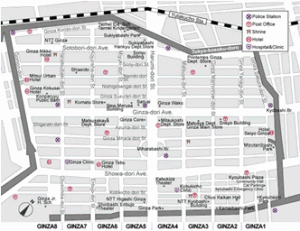 so we didn’t realize that we should force ourselves to immediately put our bodies on local time. The mid-day naps we took in Tokyo only made matters worse. But, we found time to do some sightseeing, and rode the subway into downtown Tokyo. We wanted to see the Ginza, but how does one know the character for Ginza? We also journeyed on a monorail out into the countryside, and were amazed by the speed and comfort of the ride. We hung around the hotel room sometimes, and the children got a big kick out of watching TV and viewing Ponderosa in Japanese. We also roamed around some temples we found, but perhaps we were disrespectful. At one point we saw that a robed gentleman was following us and decided we should be more careful.
so we didn’t realize that we should force ourselves to immediately put our bodies on local time. The mid-day naps we took in Tokyo only made matters worse. But, we found time to do some sightseeing, and rode the subway into downtown Tokyo. We wanted to see the Ginza, but how does one know the character for Ginza? We also journeyed on a monorail out into the countryside, and were amazed by the speed and comfort of the ride. We hung around the hotel room sometimes, and the children got a big kick out of watching TV and viewing Ponderosa in Japanese. We also roamed around some temples we found, but perhaps we were disrespectful. At one point we saw that a robed gentleman was following us and decided we should be more careful.
When we made the reservations to fly to Cebu and return, we found that while Tokyo was the first stop after the US, we could reach the Philippines by way of a side trip to Hong Kong. “Why not go there first,” Sally asked, and so that was our next stop. It is about a 4-hour flying time to Hong Kong from Tokyo, and so we were able to schedule it during daylight hours. The airport at Hong Kong is nestled between two mountains, and it is a bit tricky to maneuver for a safe landing. Well, on the first pass the pilot had to abort the landing attempt, and swing around for another try. This caused a fair amount of consternation among the passengers, and the conversation on the plane stopped quickly. We had picked up some toys in Tokyo for the children to play with, and Mark had a device that had a windup clock in it. As we aborted our first pass at the airport, Mark wound the clock and released it. So, suddenly there was this loud ticking noise, and screams of fear arose from some of the passengers. We tried to tell everyone that it was only a toy, but that was not quickly understood. But the second time the landing attempt was successful, and we soon were deplaned.
We had a reservation at the August Moon Hotel in Kowloon, so after clearing customs and immigration we taxiied over there. Of course the sights and sounds of Hong Kong overwhelmed our senses. The horns of the Star ferry beckoned us, so we boarded the ferry over to Hong Kong Island. It seemed the harbor was teeming with boats of all descriptions, and barely room for even one more.
Arriving on Hong Kong Island we looked for the Ladder Street and for a while considered climbing it. But, Victoria Peak was in need of being explored, and so we clattered on a cable train to the top to view Hong Kong from that vantage point. We also wanted to visit Aberdeen Harbor where so many people lived on boats, and stayed on the water for most of their lives. On the hillside above Hong Kong we saw the shacks of the poorest of the poor – people who had fled from Mao Tse Tung’s China and were barely eking out a living. We toyed with the idea of taking a train through the New Territories to Shenzen, but decided that was too much for such a short stopover.
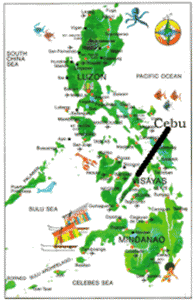 After a few days in Hong Kong we continued on to the Philippines. It was a few-hour flight to Manila, and we arrived in late afternoon. We had to go through immigration and then claim our baggage before going through Customs. The heat and humidity was overbearing and sweat just poured off us. We had many pieces of baggage, as we knew we would be staying at least a year. We did not have any language difficulty as English is spoken throughout the country. We found that we had to change terminals from the International terminal to the domestic terminal to catch the flight to Cebu. This caused no end of tension, as we had to hire more than one taxi to get all of our baggage and us safely transported. Many of the taxies did not use a meter and it meant fixing the price for the ride before we loaded our baggage. This took some doing, as the taxi drivers understanding of English seemed to decay as we tried to negotiate a lower price.
After a few days in Hong Kong we continued on to the Philippines. It was a few-hour flight to Manila, and we arrived in late afternoon. We had to go through immigration and then claim our baggage before going through Customs. The heat and humidity was overbearing and sweat just poured off us. We had many pieces of baggage, as we knew we would be staying at least a year. We did not have any language difficulty as English is spoken throughout the country. We found that we had to change terminals from the International terminal to the domestic terminal to catch the flight to Cebu. This caused no end of tension, as we had to hire more than one taxi to get all of our baggage and us safely transported. Many of the taxies did not use a meter and it meant fixing the price for the ride before we loaded our baggage. This took some doing, as the taxi drivers understanding of English seemed to decay as we tried to negotiate a lower price.
By late afternoon we were flying to Cebu, and marveling at the beauty of the islands. We flew south from Manila over southern Luzon, caught sight of Mindoro Island, and soon we approached Panay, Negros, and the western edge of Cebu. Cebu is one of the islands in the central Philippines, and this region is known as the Visayas. The other two major regions of the Philippines are the islands of Luzon and Mindanao. The Visayas are roughly at 8 degrees north latitude, thus about 500 miles north of the equator. Thus, while we landed in daylight, in the next few minutes night fell and we deplaned in pitch dark.
Of course there were no jet-ways, so we trudged across the tarmac to the terminal building. There we were met by the welcoming team of Pedro Yap the assistant Dean of Engineering, Benedicto Supremo the chair of the Electrical Engineering Department, Father John Berry of the Presidents Office of the University, and other members of the Engineering College. Several of the faculty members had driven cars or trucks to the airport, so we had plenty of room for the five Brulé’s and their baggage.
Sally & I were in the car with Pedro Yap, and we were torn between talking with him and being overwhelmed by the new world we were in. Pedro inquired as to how large our family was, and we replied ‘Counting the three children there are five of us.’ Pedro used that to indicate to us that he has 9 children. He was a guerilla fighter on Cebu during the Japanese occupation of the island in World War II. He was on the island when it was ‘liberated’ by the US troops in 1945. He then served with the US forces during the occupation. He said to me, ‘John, there was one problem that I had to face at that time.’ I asked him to tell me about it, and he did so at some length. ‘I was concerned about what to do about the mess hall arrangements.’ ‘Why was that?’ I inquired most innocently. ‘Well’, he said, ‘I had to find out if I was to eat with the blacks or the whites’. (Remember that there was segregation in the US military at that time.)
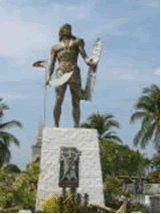 Our plane had landed on the island of Mactan, and so we had to cross over to the main island of Cebu, which is about ¼ mile away. There was no bridge, the previous bridge having been destroyed in a typhoon. (A typhoon in the Eastern Hemisphere is the same as a hurricane in the Western Hemisphere.) So our caravan headed for the shore, and drove onto LST’s. These ships, which were left over from the war, were now serving as ferries. There was much evidence of the war still around. For example, an electrical generator that was on an LST supplied part of the power needed by Cebu City.
Our plane had landed on the island of Mactan, and so we had to cross over to the main island of Cebu, which is about ¼ mile away. There was no bridge, the previous bridge having been destroyed in a typhoon. (A typhoon in the Eastern Hemisphere is the same as a hurricane in the Western Hemisphere.) So our caravan headed for the shore, and drove onto LST’s. These ships, which were left over from the war, were now serving as ferries. There was much evidence of the war still around. For example, an electrical generator that was on an LST supplied part of the power needed by Cebu City.
Well, it was only a few minutes ride across the water to the main island, and we were taken to the Hotel Magellan for our first night in Cebu. Magellan is a big name around Cebu because it was on the island of Mactan that the freedom fighter Lapu-Lapu disposed of Magellan in 1521.
The picture is that of a statue of Lapu-Lapu that is in Lapu-Lapu City on Mactan. What had happened to Magellan is that a cohort of Spaniards landed on Mactan for the purpose of subduing Lapu-Lapu and his men. In the bloody battle that ensued, the Spaniards with their armor and guns were overwhelmed by the native warriors, led by Lapu-Lapu, and were all killed. Lapu-Lapu was the first Filipino chieftain to resist the Spanish invasion and their attempt to make the Philippines a colony of Spain. For the next 54 years no Spaniard dared to set foot on Philippine soil and Lapu-Lapu went down in history as the Philippines first national hero.[1]
At the time the Magellan Hotel was the elite hotel in Cebu City, and probably the nicest hotel outside of Manila. Even to this day I view the Philippines as having two distinct sections. One is Manila, and the other is the rest of the country. For example, while we were in the Philippines I bought a car, and thus needed a Filipino drivers license. Filling out the paper work went OK in Cebu City, but then the material had to be sent to Manila for processing and eventual issuance of the license.
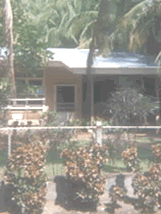 On the following day we were introduced to many people throughout the administration, from the President, Father Rahmann on down. The University had made arrangements for us to rent a house on the street Andres Abellana, in the Capital district of Cebu City. So we went there the next day to look it over. The house had a nice lot, and three bedrooms on an upper level. The main floor had a large dining/living room, a kitchen, a maid’s room, and a wash room. We were also told that we should hire a cook and a maid. Sally was quite concerned about this, as she had no experience with hired help. But the need to do shopping for food in the city market, contact with vendors, laundry, and maintenance of the house soon convinced her that it was worth a try.
On the following day we were introduced to many people throughout the administration, from the President, Father Rahmann on down. The University had made arrangements for us to rent a house on the street Andres Abellana, in the Capital district of Cebu City. So we went there the next day to look it over. The house had a nice lot, and three bedrooms on an upper level. The main floor had a large dining/living room, a kitchen, a maid’s room, and a wash room. We were also told that we should hire a cook and a maid. Sally was quite concerned about this, as she had no experience with hired help. But the need to do shopping for food in the city market, contact with vendors, laundry, and maintenance of the house soon convinced her that it was worth a try.
So, we had the word passed around that we were looking for some help, and soon Remey Torrejo and her niece Rere showed up. Remey had worked for foreigners before, and her English was very good. So we hired them right away; Remey as the cook and leader, Rere as the lavendara and maid. However, there was a lot of tuberculosis in Cebu at that time, so we required that they both get x-rayed to check upon their condition. The x-rays showed that they both had scar tissue, but were not infected at this time. We also told Remey that whenever food was carried in to our table that she should first wash her hands. From that day on her hands were always dripping wet whenever our food was served.
One of our first concerns was to get the children into school. Mark had just turned 6, and we found a place for him in St. Theresa’s school. He was put in a grade called prep, since there was no equivalent to first grade. He carried quite a burden in school, since he was the only blond in his grade. But, two doors down the street on Andres Abellana there were another American family, Bud and Judie Adams, and they had a son just Mark’s age. So, he had a buddy, Chuckie, to play with. Chuckies dad was a researcher at the local leprosarium, and I’ll say more about that later.
Nannette was in heaven in the Philippines. She has the same skin tone, and dark hair, as many filipinas and she just integrated right in to the society. She too went to St. Theresa’s, and immediately made a lot of friends. In addition she was able to have real live pets, so she soon acquired a young goat. She loved that goat like it was her child. At first it had a free run of the yard, but we soon noticed that the flowers on all the flowering bushes were disappearing. The flowers were tasty morsels for the little goat, and he made short work of them. After we had been there a few months the goat got sick, and Nannette was devastated. We contacted the leprosarium to see if there was a veterinarian there, and indeed one showed up at the house that evening. However the little goat was beyond saving, and it died in Nannette’s arms that night. She wanted us to mount the head, but we talked her out of that. Anyway, there were several turkeys in the yard next door, and she moved her mothering to them.
Jim entered school at the Boy’s High School of the University of San Carlos. He too had a great time being a standout person. That is, he was at least a head taller than anybody in the entire school. Everybody assumed he was a great basketball player, and was expected to be a standout in that area too. However, Jim is no great athlete, but has a great aptitude for making friends, and soon he was well accepted by his classmates and teacher.
At first Sally was totally consumed with getting the house in order and developing good relations with Remey and Rere. There was much to be learned about how shopping is done here in Cebu City, where the good stores are, getting to and from the large city market, Carbone. Having the Adams’ nearby was a great help also. They had lived in Cebu for a year, and Bud was quite busy at the leprosaurium. Judie and Sally hit it off right away and that helped make the transition smoother.
 I went to the Engineering College, and started to meet the faculty. I met the Dean of Engineering, Jose Rodriguez. He had been Dean since shortly after the end of World War II. The main building of the Engineering College is in the barrio Talamban, about 8 kilometers (5miles) out of the city. At first I took a taxi to get there, but when I learned about which jeepney to ride, I switched to that mode. The jeepney is the most widely used form of transportation throughout the Philippines. They all are highly decorated and colorfully adorned. Usually two passengers ride up front with the driver, and the rest of us ride on side benches. Often a helper will hang on to the back of the jeepney and collect the fares. But usually the driver is alone and the passengers each pay the driver as they leave the jeepney. The fare when we first arrived in the Philippines was 10 centavos, with 100 centavos in a peso. At that time in 1967 the peso was worth about 25 cents. A jeepney had the sign: “God Knows, Judas not Pay.” The full meaning of that line becomes apparent when you remember that the J has the sound of H.
I went to the Engineering College, and started to meet the faculty. I met the Dean of Engineering, Jose Rodriguez. He had been Dean since shortly after the end of World War II. The main building of the Engineering College is in the barrio Talamban, about 8 kilometers (5miles) out of the city. At first I took a taxi to get there, but when I learned about which jeepney to ride, I switched to that mode. The jeepney is the most widely used form of transportation throughout the Philippines. They all are highly decorated and colorfully adorned. Usually two passengers ride up front with the driver, and the rest of us ride on side benches. Often a helper will hang on to the back of the jeepney and collect the fares. But usually the driver is alone and the passengers each pay the driver as they leave the jeepney. The fare when we first arrived in the Philippines was 10 centavos, with 100 centavos in a peso. At that time in 1967 the peso was worth about 25 cents. A jeepney had the sign: “God Knows, Judas not Pay.” The full meaning of that line becomes apparent when you remember that the J has the sound of H.
One common misconception is that the Philippines is a Spanish speaking country. While the Spanish occupied the country for centuries, nevertheless they did not have any real school system for the filipinos, other than the teaching of religion. There was a mandatory course in Spanish that students had to take, but Spanish was never introduced to the population as a whole. Altogether there are some 87 dialects throughout the country, and one attempt at a national language, called Filipino. On the island of Luzon the main language is Tagalog, which is closely allied to Filipino. The people of Cebu speak Cebuano, and most of them also speak English.
The University of San Carlos has several campuses around Cebu City. The main building is in the central part of the city, and is where the administrative offices of the University are located. The school is owned and operated by the Society of the Divine Word, SVD. At the time of our arrival there in 1967 all the higher officers of the University were priests of the SVD order. Further, none of these officers were Filipinos. There were four major nationalities among the religious personnel at USC. These are Dutch, German, Filipino and American. As Sally put it, the Dutch and the Germans did not like each other, and they both disliked the Americans. And, of course, none of them paid any attention to the Filipinos.
I would go to the main building from time to time to attend meetings, and get to know the people there. Two particularly interesting people were Father Verstrallen and Brother Willibrod. (Both of these men were from the Netherlands.) Verstrallen was heavily involved with studying people in a remote section of Mindanao – he was learning their language and constructing a dictionary. Brother Willie was an assistant to the Finance Officer. But they also had a deep interest in the well being of the people in Cebu City.
There were many children in the city that did not have any family to see to their needs, and their situation was of concern to these two fine men. The young girls were seriously at risk, and if left alone would be exploited terribly and would end up as prostitutes. There was an orphanage that opened the doors to them, and some took advantage of the offer of help. The young boys basically lived on the street, and made a living as best they could. Many of them would carry a box filled with many different brands of cigarettes. When a jeepney would stop at a traffic jam (there were no stoplights in Cebu City at this time) the boys would rush to the sides of the jeepney and sell cigarettes. Filipinos would usually buy just one cigarette at a time when they were on the jeepney. So the boy would sell the cigarette and light it for the purchaser.
Another source of income was that some boys would offer to watch your car. When you found a parking spot someplace they would rush over and offer to watch your car while you were gone. It was always wisest to accept one offer, and when you returned to your car you would give him a tip. A third source of income was most distressful to the driver of the car. In this case when your car would be stopped for some reason, a couple of boys would rush over each holding probably the dirtiest rag you had ever seen. Covered with oil and dirt they would offer to “wipe your windows, Sir?” and you had to somehow convince them that you appreciated the offer, but didn’t want to use them just now. A tip would take care of that situation.
The boys would sleep in local theaters, and anyplace else they could find some cover. As a result their personal hygiene left a lot to be desired. Brother Willie and Fr. Verstrallen would see to it that they got some food and would work with them somewhat to try to give them some fundamental instruction. One thing they did was each Sunday they would take them to a beach rest area, Miramar, operated by USC. There was a swimming pool at this place, and the pool was drained each Sunday. (There was no water pump to circulate the pool water, and of course no chlorine in the water.) The officers of USC were quite concerned about the boys swimming in their pool, but finally agreed to let them because the pool was drained immediately after.
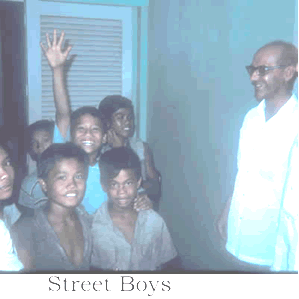 Sally and I got involved with this activity to the extent that we would go out to Miramar each Sunday afternoon, and bring a couple of bagsful of sweet rolls. We would be around with them while they swam, and then pass out the rolls for a little snack. One day Brother Willie and Father Verstrallen brought them to our house prior to the swim, and this picture shows them as they greeted us. That is Father Verstrallen on the right, along with a little bit of Brother Willie. We figured that they had worn their shirts and pants for quite some time, so we went out and bought replacement clothes for the. The other picture shows them in their new attire. Of course, within a day or two the new clothes in lower picture took on the form of the clothes in the upper picture.
Sally and I got involved with this activity to the extent that we would go out to Miramar each Sunday afternoon, and bring a couple of bagsful of sweet rolls. We would be around with them while they swam, and then pass out the rolls for a little snack. One day Brother Willie and Father Verstrallen brought them to our house prior to the swim, and this picture shows them as they greeted us. That is Father Verstrallen on the right, along with a little bit of Brother Willie. We figured that they had worn their shirts and pants for quite some time, so we went out and bought replacement clothes for the. The other picture shows them in their new attire. Of course, within a day or two the new clothes in lower picture took on the form of the clothes in the upper picture.
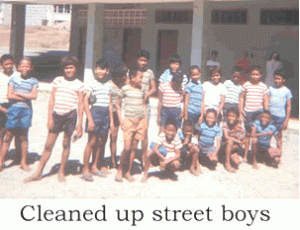 This picture was taken at another part of the University. This place was known as Girls High School, and was a few kilometers from the main building. Jim went to Boys High School, which was in still another part of the Cebu City.
This picture was taken at another part of the University. This place was known as Girls High School, and was a few kilometers from the main building. Jim went to Boys High School, which was in still another part of the Cebu City.
Each evening after we all arrived home from our daytime activities we would sit around the table and unload our experiences of the day. There always was some astounding activity that required sharing with the family. One evening Nannette did not show up from school, and we had a panic in the house. We really didn’t know the names of the people she went to school with, so it took a lot of phoning to everyone we knew to try to track her down. Well it turned out that she had been invited to the home of one of her friends, and they didn’t have a direct means to get in touch with us. Eventually she turned up, and you may be certain that Sally had a few words to say to the family who had entertained her.
One time Jim indicated that he would like to have a party in the house with his friends. We thought this was a good idea, and checked with Remey to work out a menu. One of Jim’s friends told us that we should hire a guard for the night, and we reluctantly did so. It turned out that was a good idea because a number of people Jim didn’t know turned up to attend the party. The word had gotten around that the Americano was to have a party, and that was sufficient to attract a few strangers.
My work at the University had several different aspects to it. I taught a course to Undergraduate students and this gave me some insight into characteristics of the engineering student body. I also taught courses to the faculty. Some were for upgrading their understanding of the material they were teaching, and other courses introduced them to new features of Electrical Engineering. For these courses I prepared lengthy notes, and the faculty members who took the courses were deeply involved in study and doing the homework I assigned. (I returned to the department 9 years later on another sabbatical and found the notes were still in use.)
The faculty members in the University are paid on a per credit hour basis. That is, they are paid so many pesos per credit hour they teach. Thus, every faculty member was very anxious to teach as many credit hours as the University would allow. This is just the opposite of the desires of the faculty member in the US. At Syracuse University the average faculty member would teach perhaps 6 credit hours per semester. In the Philippines a faculty member would teach say 27 credit hours per semester at one school, and then go to another local engineering school and teach another 6 to 12 credit hours. Basically this is done so the faculty member can earn a moderately good income. (The credit hours are counted the same way in the US and the Philippines.)
So, in the courses I taught to faculty I had to take this into consideration in the way I conducted the course, and what I could expect of them to do with homework.
The chair of the department, Benedicto Supremo, was working on a master’s degree in the Physics department. He needed a thesis to finish up the degree, and the Physics faculty said I could be his advisor on some topic in Electrical Engineering. So, we looked over what was available, and Supremo was interested in motors and such. He was able to write a good thesis on the dynamic response of a motor-generator system. This involved solving some non-linear differential equations and he did this using numerical methods and a mechanical desk calculator. The department had an old analog computer, but it wasn’t big enough, or reliable enough, for him to use. So he punched away on the mechanical calculator. There was no digital computer anywhere in the Philippines for him to use.
Sally found that she had a lot of free time, and she started going to meetings of various civic organizations. The elite of Cebu City were members of the Club Espanol, but she had no desire to join that organization. She went to the University to see if there was anything she could do to help, and was told that there was a blind student that could use someone to read aloud to her. Her name is Nellie Flores, and she somehow got admitted to the University in spite of her inability to read written material. Sally would go to Nellie’s apartment a couple of times a week and read to her. It was a small apartment, so Sally had to sit on the bed while Nellie listened and made notes on her little braille board. Sally found out the hard way that there were bedbugs in Nellie’s apartment, so they soon found a different place to meet.
Sea Urchins
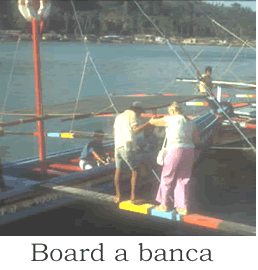 The people in the department would, from time to time, have a gathering of the families. Of course we would meet at a beach and have a day of swimming, snorkeling, and general bonding. The big danger most of us were aware of was the need to protect ourselves from the sun. Being on the ocean in the tropics is delightful experience, but sunstroke is always a danger. Also, the tides resulted in a change of water level of about 3 feet. That isn’t so much, but when we are swimming at a nice beach that is quite shallow then there can be quite a change in where the shoreline is.
The people in the department would, from time to time, have a gathering of the families. Of course we would meet at a beach and have a day of swimming, snorkeling, and general bonding. The big danger most of us were aware of was the need to protect ourselves from the sun. Being on the ocean in the tropics is delightful experience, but sunstroke is always a danger. Also, the tides resulted in a change of water level of about 3 feet. That isn’t so much, but when we are swimming at a nice beach that is quite shallow then there can be quite a change in where the shoreline is.
One day we were all having a great time, and a dozen or so parents and children decided to get on a banca and go out and explore a nearby island. The picture shows a banca, with Sally boarding it. However, she did not get on the banca this day.
 The group left the beach as the tide was going out, and they were gone a few hours. When they returned they found that the water had become so shallow that they had to debark from the banca at a distance of about 100 yards from the shore. The floor of the ocean in this interval was just thick with sea urchins, and they all started walking towards the shore. Well it didn’t take more than a couple of steps before the children screamed and started crying because they couldn’t step between the sea urchins and thus were getting spines into their feet. So, what could they do? The bancas couldn’t get closer to the shore, and so the men that were on board each took a child on their backs and waded through the sea urchins! We who were on the shore could see the pain on their faces, and also hear their shouts of anger/pain. What a sorry sight, and what a way to end a joyful day at the beach.
The group left the beach as the tide was going out, and they were gone a few hours. When they returned they found that the water had become so shallow that they had to debark from the banca at a distance of about 100 yards from the shore. The floor of the ocean in this interval was just thick with sea urchins, and they all started walking towards the shore. Well it didn’t take more than a couple of steps before the children screamed and started crying because they couldn’t step between the sea urchins and thus were getting spines into their feet. So, what could they do? The bancas couldn’t get closer to the shore, and so the men that were on board each took a child on their backs and waded through the sea urchins! We who were on the shore could see the pain on their faces, and also hear their shouts of anger/pain. What a sorry sight, and what a way to end a joyful day at the beach.
As the men reached shore it was necessary to remove the spines from their feet, and this was readily accomplished. The spines can be easily removed if the foot is soaked in an ammonia solution. Thus all the men and boys had a busy time contributing to the collection of ammonia.
On a later trip taken by the family we went to Davao City on Mindanao, and had another encounter with sea urchins. Nannette managed to stumble onto one while we were walking along the shore. Again the boys came to her rescue and soon the spines were removed from her foot.
We were treated most generously during our stay on Cebu. One fine man, Al Tantoco, took us under his wing to make sure that we saw all the good things in and around Cebu City. Every weekend for the first several weeks of our stay he would make arrangements to pick us up and take us around in his car. Al was Chairman of the department some years before I got there, but was now an employee of the airport on Mactan. One trip was a ride up into the hills above Cebu City to the small town of CarCar. The road was quite bumpy and curved around the hills as we climbed to the summit. In CarCar there was a small church, a central square, and housing for a hundred people or so. We got out of the car at the square to stretch our legs and were immediately surrounded by young people and by vendors wanting us to buy rice cakes. These particular rice cakes are unique to CarCar, and we found them to be very tasty. Sally and I both enjoyed them as a delightful snack when we would have a drink before dinner.
As we started to settle in for our life in the Philippines we spent some time with the priests who taught and resided in the main building. I met the President of the University, Father Rahmann. He was a remarkable man and largely responsible for raising the level of competence of the entire University. Many of the faculty members were German SVD’s who had been living in China prior to coming to the Philippines. When the Japanese invaded China the German SVD’s were not interned. This was because Japan and Germany were fighting common enemies – the Allies of Britain, the USA, and others. However when the Communists of Mao Tse Tung took over the mainland in 1949 the German SVD’s left China and came over to the Philippines.
We became friendly with Father John Berry, and Father Tom Mueller. They both were very active in University politics, so I learned a lot about who was doing what in the various schools. The Father’s regularly have a gathering on Sunday evenings in a bar room on the top floor of the main building. Sally and I would go to that from time to time and enjoy an evening of gossip and bonding. After we left the Philippines we kept in touch with John and Tom. Tom ended up marrying a Chinese woman, and they moved to Oregon and he became involved with a University there. John married a former nun, and Sally and I attended their wedding in the Bronx. John was a great drinking buddy, and in later years we met from time to time, first in Washington DC, and then in Houston, Texas where he was teaching at a University. We also developed a relationship with Father Hans Werner, and sometimes we would have them over for dinner.
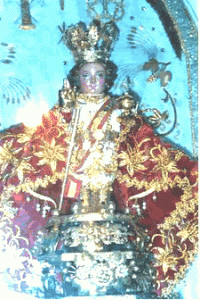 Hans took great pleasure in relating stories about filipino myths, and giving modern interpretations. The feast of the Santo Nino occurs in mid January, and Cebu is the center of the observances that go on throughout the Philippines. Nowadays this is called the Sinulog. One story is that during this period the Santo Nino and the black Madonna disappear and meet on the island of Mactan. The story goes that as a result of this meeting the human line is continued. The figure to the left is the classic figure of the Santo Nino. The next figure shows the women dancing outside the Basilica of the Santo Nino in Cebu. The women are dancing to help people with their prayers. Anybody can purchase a candle and then give it to one of these women to perform their dance for them in the hope that the prayer will be answered. Usually the prayer is a call to assist the penitent to achieve her desired state of being pregnant.
Hans took great pleasure in relating stories about filipino myths, and giving modern interpretations. The feast of the Santo Nino occurs in mid January, and Cebu is the center of the observances that go on throughout the Philippines. Nowadays this is called the Sinulog. One story is that during this period the Santo Nino and the black Madonna disappear and meet on the island of Mactan. The story goes that as a result of this meeting the human line is continued. The figure to the left is the classic figure of the Santo Nino. The next figure shows the women dancing outside the Basilica of the Santo Nino in Cebu. The women are dancing to help people with their prayers. Anybody can purchase a candle and then give it to one of these women to perform their dance for them in the hope that the prayer will be answered. Usually the prayer is a call to assist the penitent to achieve her desired state of being pregnant.
The Sinulog has become an important event for many communities throughout the Philippines. In Cebu City the main feature is a parade, as also shown in another picture. In fact each barrio and gated community in Cebu City will have their own parade, led by the barrio captain, and featuring all the notables of the community.
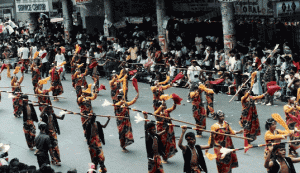 The picture below shows one small part of the parade that went down one of the main streets of Cebu City. The people line the streets to see all the participants in their costumes and listen to the music of the marching bands.
The picture below shows one small part of the parade that went down one of the main streets of Cebu City. The people line the streets to see all the participants in their costumes and listen to the music of the marching bands.
One of the larger religious celebrations in Cebu City is the observance of Holy week, in particular Holy Thursday and Good Friday. In the evening of Holy Thursday many young people go up into the hills to gather branches, and commune with nature. Then on Friday they return, and in general flagellate themselves with those branches, and participate in areenactment of the crucifixion. 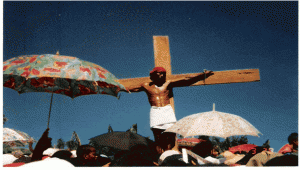 The crucifixion is real and begins with a procession through the streets. Eventually they reach the desired open space and the penitent is nailed to the cross with steel spikes driven through his hands and feet. This man stayed on the cross for the full three hours in the blazing sun. It was not only that he was able to stand the pain, but surprisingly didn’t suffer from heat stroke. The time around Easter Sunday is the beginning of the summer in the Philippines and it gets quite hot in the direct sun during the summer. It seems to me that in the Philippines the event of the crucifixion and death of Christ is more important than the resurrection. Also, All Souls day, November 2, (sometimes called the Day of the Dead) is more important than All Saints day, November 1. The day purposely follows All Saint’s Day in order to shift the focus from those in heaven to those in suffering.
The crucifixion is real and begins with a procession through the streets. Eventually they reach the desired open space and the penitent is nailed to the cross with steel spikes driven through his hands and feet. This man stayed on the cross for the full three hours in the blazing sun. It was not only that he was able to stand the pain, but surprisingly didn’t suffer from heat stroke. The time around Easter Sunday is the beginning of the summer in the Philippines and it gets quite hot in the direct sun during the summer. It seems to me that in the Philippines the event of the crucifixion and death of Christ is more important than the resurrection. Also, All Souls day, November 2, (sometimes called the Day of the Dead) is more important than All Saints day, November 1. The day purposely follows All Saint’s Day in order to shift the focus from those in heaven to those in suffering.
 After we had been in the Philippines for several months we decided to take a trip to Bohol. This is an island very close to Cebu, so we went there by ferryboat rather than flying. We were drawn there by the word that many fine orchids were in the market in Tagbilaran, main city of Bohol. So we found a hotel in the city and looked around at the market there. But, the real attraction, for me at least, is to the Chocolate Hills. As you can see in the picture the hills look like chocolate drops and in the dry season the leaves on the trees turn brown, and the likeness becomes striking. We hired a taxi to take us up to the hills, and spent the night there in a dormitory. It was a full moon night, and the view was spectacular.
After we had been in the Philippines for several months we decided to take a trip to Bohol. This is an island very close to Cebu, so we went there by ferryboat rather than flying. We were drawn there by the word that many fine orchids were in the market in Tagbilaran, main city of Bohol. So we found a hotel in the city and looked around at the market there. But, the real attraction, for me at least, is to the Chocolate Hills. As you can see in the picture the hills look like chocolate drops and in the dry season the leaves on the trees turn brown, and the likeness becomes striking. We hired a taxi to take us up to the hills, and spent the night there in a dormitory. It was a full moon night, and the view was spectacular.
The next morning we decided to take jeepney’s back to Tagbilaran, so we walked back to the main road and boarded the first jeepney that came by. We were sure that all of them were headed into Tagbilaran and were not worried about finding the right one. The jeep had several people on it, and so we had a nice conversation with them. “How old are you?” was the first word out of the man next to me. “Forty”, I said, and before I could ask him his age he assured me that he was much older than I was. “How many children do you have? a woman asked Sally. Of course when she replied 3 we were assured that we had a very small family.
We got out at the first barrio we encountered, and looked over their market. We didn’t see anything unusual, so we jumped on another jeepney and continued doing this, eventually ending up back in Tagbilaran. When we got back there it was nightfall, so we spent another night on Bohol.
We had heard that there was an interesting cave a few miles down the road, so we hired a taxi and went to find it. Sure enough we soon located it, jumped out of the taxi to explore it. We had been warned that there were lots of bats in the cave, so we entered it without making much of a fuss. It was quite large, with a deep pond in the center of the cave. We could see the bats way up on the ceiling, but they were ignoring us. Well, it was a hot day and we had worn our swimming suits, so we went in for a dip in the pond. That was quite refreshing, and as soon as we were cooled off we climbed back out of the cave, got in the taxi and caught the next ferry back to Cebu.
 It is interesting to note that some years later (in 2003) I returned to the Philippines with Dolores and my granddaughter Rachel and we visited some of the places that Sally & I frequented in 1967-68. On our trip to Bohol in 2003 we tracked down a small monkey called a tarsier , as shown in this picture. The tarsier is about the size of a small person’s hand, and spends most of the day sleeping. It is an endangered species as you might well imagine.
It is interesting to note that some years later (in 2003) I returned to the Philippines with Dolores and my granddaughter Rachel and we visited some of the places that Sally & I frequented in 1967-68. On our trip to Bohol in 2003 we tracked down a small monkey called a tarsier , as shown in this picture. The tarsier is about the size of a small person’s hand, and spends most of the day sleeping. It is an endangered species as you might well imagine.
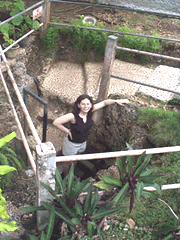 We also went back to the cave and here is a picture of Rachel part way into the cave. They added the cement steps, but otherwise not much else was different from what it was in 1967. The picture down below shows the cave entrance.
We also went back to the cave and here is a picture of Rachel part way into the cave. They added the cement steps, but otherwise not much else was different from what it was in 1967. The picture down below shows the cave entrance.
We visited several other islands throughout the Philippines including Palawan, Negros both occidental and oriental, Panay, Leyte, and Mindanao.
A particularly difficult visit was the one we made to Leyte. This is the island where MacArthur first landed on his return to the Philippines from Australia towards the end of World War II. So, we decided to go over there and check it out. First we saw a large and unbelievably noisy electrical generating station. The source of the noise, and the energy for generating electricity, was geothermal. I sounded like a thousand jackhammers pounding at once. The personnel in the station all wore thick protective ear covers, but even those were insufficient.
We then hired a car to take us to the eastern shore of Leyte to the city of Tacloban. The road across the island was under construction, and extremely wet. The car we were in sat low on its springs, and the interior of the car was sopping wet before we had gone more than a hundred yards of the several mile trip. Along the way we met a caravan of Japanese tourists. Apparently they too were on their way to Tacloban. It seems Red Beach, which is near Tacloban, is a memorial for the Japanese since many of their soldiers were killed during the battle for Leyte.
MacArthur had landed at Red Beach, and there are several larger than life size statues of MacArthur, Quezon, and others shown wading through the surf to reach the shore. The local story is that MacArthur was furious with the people who had planned his entrance as a photo op. The LST that he rode in on had to stop several yards out from the shore as the tide was out. Thus he had to wade through some water and he got his clothes quite wet.
Sally and Mark and I visited Tacloban again in 1978-9 on our second trip to the Philippines. This time we flew into Tacloban from Cebu City, and found a pensione in which to stay. During the night I suffered a severe pain in my side, and we were sure that it was due to a kidney stone. The pain was so severe that I felt I had to get medical attention. There are two hospitals in Tacloban, St. Louis and Tacloban General. St. Louis had an emergency room, so after some consultation decided to go there. We awakened Mark to let him know what we were doing, and told him not to worry, that we would be back in touch later. He sat up in bed while we told him this and were convinced he understood.
So we had the people at the pensione call a cab, and off Sally and I went to the hospital. I was well taken care of, and resting well a couple of hours later when Mark showed up at the room in a state of great agitation. It seems he had awakened after we left and found we had disappeared. He had no recollection of our awakening him and no one was around to answer any questions. He looked outside, and finally was able to rouse someone that he could talk with. This was about 4:00 a.m. or so. After much discussion they figured out that they had heard something going on during the night, and decided to check the hospitals. That’s how Mark found us! I am afraid that this scar will be on Mark for quite some time. That day we flew back to Cebu City, and tried to resume our life.
Another trip we took was to the island of Mindanao. This is the second largest island in the Philippines, and the religion of people there is by and large muslim while the rest of the Philippines is Christian and mainly Catholic. The muslims of Mindanao have resisted being governed by anyone since the early days of colonization by Spain. It is another world there, and strangers of any sort are viewed with suspicion. Being Caucasian is somewhat more negative.
So, we flew to Davao City, which is at the Eastern end of the island. We stayed in a beautiful resort there, the Davao Insular. That is where Nannette went swimming and encountered another sea urchin. Davao is also noted for its special fruit, the durian. This fruit smells so strongly that it is not permissible to bring it on board an airplane. So we went out and bought one, but were warned not to bring it to our room. We went outside to the pool area, cut it open, and came to the conclusion that it tasted as bad as it smelled.
After a few days we flew to Zamboanga City, which is at the far southwestern edge of the island. On the way the plane stopped at Cotabato, and we had a couple of hours layover. The airport is a couple of miles out of the city, so we inquired about taking a taxi into town to see what it looked like. We were strongly advised to stay put in the airport and not go out on any excursion. Cotabato is one of those hot spots, and has a rather violent reputation. It seems that on the previous Easter Sunday some person was shot and killed in a church there as he was receiving communion.
Flying on to Zamboanga was completed without incident.
We had made reservations at the Bayute Hotel so we were all set. We spent New Year’s eve at this hotel and set off firecrackers in an old cannon sitting on the beach. While we were sitting on the shore that night we noticed a small boat leave a rather large banca and be rowed to the shore. The small boat was almost swamped but the men were very careful while rowing to the shore. Once there it took four men to lift up a chest it was carrying and get it onto a jeepney. The jeepney left as soon as the chest was loaded. Zamboanga is noted for its wide variety of goods that can be purchased, and at very good prices.
While exploring Zamboanga the next day we came upon a very nice city park. It had a long slide in it that went down a hill and ended in a swimming pool. We all had a great time doing this for an hour or so, but all sliding ended abruptly when it was noticed that the bottoms of our swimming suits were practically worn away. The slide was concrete, and consequently was quite rough on the material of our suits. Nevertheless we had an exciting time for a while and flew back to Cebu City in great spirits.
After we had been in Cebu for a few months I decided it was time we had our own transportation, so we looked around and finally bought a second hand Renault. It served us well so that we could ride around Cebu and visit more of the outlying barrios. We drove up the east coast of Cebu to Danao City, since we heard there were some interesting sites there. Danao City is run by the Durano family, and they controlled everything in it. Schools, hospitals and all such services were made available by them. In fact, even the one hearse in the city served the family. On the side of the vehicle there was the sign: “Your last ride is free.”
Mr. Durano was quite generous, as you can see from his offer of a ride. But he also viewed himself as a religious man, and he created an almost unbelievable “holy” spot. He decided to take many of the major ideas of the New Testament and make chapels for each one. Thus he created these chapels, populated by larger than life statues, of each of the 15 mysteries associated with the rosary, the 14 stations of the cross, the 12 apostles and had created busts of most of the Popes of the Roman Catholic Church. These last figurines are placed on pedestals distributed around the grounds of another garden. Finally, the body of Ramone Durano, the patriarch of all this, rests in a grotto in the center of the “holy” spot. A figure of Jesus stands at the open door of the grotto gesturing for you to enter.
It is worthwhile to point out now that over the years the Brulé family developed a close connection to the Philippines. The first trip was in 1967-68, and all 5 of us went. The second trip was in 1978-79, and Sally, Mark and I were the only ones to participate. But, this was not the end. In 1981 and again in 1984 Sally and I were in China where I was teaching at several different schools. On the way back to the USA we stopped over in Cebu for a couple of weeks each time. In 1986 Ferdinand Marcos was expelled as President of the Philippines and Cory Aquino became President. Sally & I went each year from 1987 until 1998 for a period of about 3 months each time. Sally died in January, 1998, and I made two more trips that year – one in January/February and another in September/October. Then in 2003 Dolores and I went to the Philippines, accompanied by my granddaughter Rachel. We were there about 3 weeks visiting all the places familiar to me, plus some new ones. So much of the remaining notes in this section won’t necessarily follow a chronological line, but rather I will just write about my memories.
During the years that Sally & I were in the Philippines we made many friends. One of the first was Vic Seno. He was a faculty member in the Civil Engineering Department and he has a most interesting background. Vic was single when we arrived, but he was engaged and in October, 1967, he married. I was asked to be a sponsor at the wedding and I was most honored to be there. Well, much to our surprise we found out that the wedding was at 6:00 a.m. in one of the local churches – San Nicolas. This was quite a surprise for us, as we didn’t usually get up at that hour of the morning. Anyway, we made it OK, and the wedding went off as planned.
A Filipino wedding has many rituals that we are not aware of, so we were interested to see the doves released at the appropriate time, the various veils worn and transferred, and other such activities.
After the wedding there was the reception, and that started at about 7:00 a.m. The whole thing was over by 8:30 a.m., and so now what do we do? The only thing that made any sense was to go back home, which we did, and then rolled back in bed to finish off our interrupted sleep!
Arturo Espinosa was a faculty member in the Electrical Engineering Department, and his marriage was the second one that I was a sponsor at. Art pretty much disappeared from the department shortly after that, so I didn’t have much contact in the ensuing years even though he still lives in Cebu City.
I was quite interested in the Electrical power situation in Cebu City so did a little inquiring around. The local supplier was Veco (Visayan Electric Company). A major source of electrical power was the generator on a landing craft left behind by the US troops at the end of WW II. There was all sorts of trouble with the power distribution system. For example we had to warn Remy to not touch the water faucet when she opened the refrigerator door – I got a shock more than once from that.
I asked Supremo what he knew about how power was distributed to the outlying barrios, and he told me that up the coast of Cebu there was a town which generated its own electricity from a water fall. So, one day we all got into the Renault and drove up the island to look for it. We found it in Lanao, about 40 kilometers from Danao City. Indeed there was a waterfall about15 feet high on the edge of the barrio, and a little shack right alongside of it. There was a generator in the shack being driven by a turbine at the base of the waterfall. The generator had been salvaged from and old abandoned LST, and served the whole barrio.
Electrically, the electricity came from this 2-phase generator, and four wires left the shack, 2 from each phase, and went off to the barrio. I asked some of the local people how this worked, and they filled me in on a few details. At night the voltage was so low that they really couldn’t get much light from the light bulbs. It seems that one of the two phases supplies power to everyone in the barrio except the barrio captain. The barrio captain got all the power that was generated in the other phase.
We found out that we were not the only foreigners at the University. We received word that two young men had arrived, and they too were doing some teaching. One person, Phung Lee Ong, was from VietNam, and he taught in the Anthropology department. At this time, (the mid 1960’s) the war was heating up, and he was a refugee from South VietNam.
The other young man, Paul Fawcett, was British, and was on a “peace corp” type of service in the Philippines. We got to know them quite well, especially Paul. They lived in the same building at the priests, in downtown Cebu City, and the priests were anxious to have them move into separate quarters. We had them to dinner a few times, and it turned out that Paul was a good guitar player. Jim was very anxious to learn to play the guitar, so we went to a guitar factory on Mactan and bought one for him.
Our contacts with Paul continued over the years. Paul was still in Cebu City when we left in June, 1968. Later on Paul went back to England, to continue schooling. He then went on to Toronto, and in the process of all this he met Maria, a young lady from New Zealand. Well, one thing led to another and soon they were to be married. (He also managed to get his PhD in Chemistry along the way.) We traveled to Toronto to be a part of the wedding, and Paul and Maria visited us a couple of times in Syracuse. As time went on they moved back to New Zealand, and had two children. Paul also became involved with teaching in China, and has made several trips there. In the Fall of 2006 Dolores and I intend to traveled to Australia and New Zealand, and we rebuilt our relationship with Paul and Maria.
While we were in Cebu I made some contact with another engineering school through their dean, Dean Jose Chavarria. He was interested in an analog computer that USC had, and I gave a couple of seminars to his faculty members. He belonged to a sort of luncheon club, which had the title of “The Turtles.” The group would have lunch once a month at a local hotel, and I was invited to attend. It worked out pretty good in spite of the fact that I could speak no Cebuano. Usually we drank a bit too much at the luncheon and it was necessary to return to quarters for a nap in the early afternoon.
During the year and a half I was with USC it became time to replace the Dean. Dean Jose Rodriguez decided to retire and I was asked by Father Rahmann to serve on a search committee to find a replacement. I was convinced that Rahmann wanted just a front committee because he wanted Associate Dean Pedro Yap to be appointed as the replacement. So, I decided to try to do more of a global search, and we got some advertising out around the country. This was foolish of me, since I knew so little about the politics of the University and the culture of the country. At one point we invited a total outsider to come for a visit, and he did. After he left he wrote me to let me know that he really wanted the job, but that Father Rahmann didn’t seem to like him. Shortly after that Father Rahmann called me to his office to tell me that the candidate had indicated he didn’t want the job. I showed Father President the letter from the candidate, and ever after that my relations with Father Rahmann were much cooler!
 A technician in the Engineering College was a man from the Netherlands. He went by just his last name, Pols. Maybe that’s because his first name is Cornelius. He is married to a beautiful Filipina, Tessie. I happen to have a picture of her at a party in our home. I never did get a picture of Pols. Pols was an unusual person in that he had many many complaints about the Philippines, Filipinos, USC and the engineering college in particular. However, he and I would sometimes go down to the waterfront in the evening and have a few beers and discuss world shaking matters. Pols finally went back to the Netherlands, and a couple of times his son telephoned me when he was in the US.
A technician in the Engineering College was a man from the Netherlands. He went by just his last name, Pols. Maybe that’s because his first name is Cornelius. He is married to a beautiful Filipina, Tessie. I happen to have a picture of her at a party in our home. I never did get a picture of Pols. Pols was an unusual person in that he had many many complaints about the Philippines, Filipinos, USC and the engineering college in particular. However, he and I would sometimes go down to the waterfront in the evening and have a few beers and discuss world shaking matters. Pols finally went back to the Netherlands, and a couple of times his son telephoned me when he was in the US.
Another place that Sally and I would go to was known as Eddie’s Log Cabin. This was a restaurant on the waterfront, which featured a pianist and singers. We would drop in there some times for a visit and a meal. Eddie was an ex GI that stayed on in the Philippines after the end of WW II. Over the years he got married a few times, and had several children. He served American meals at his restaurant, so if we got desperate to have a hamburger, or steak with mashed potatoes or the like we would go there. The musicians usually played tunes from the States, so it was a little bit of the US on our visit. Eddie’s is still in the same place on the waterfront, but Eddie himself passed away. He was a totally addicted cigarette smoker and his life ended in a case of lung cancer.
At one point in our first visit to the Philippines we decided to take a trip into the inner part of Mindanao. I had been invited to go there and see what the school was like, so I jumped at the chance. Mindanao is basically a Muslim country even though it is part of the Philippines. To go there on one’s own is a little risky if you go outside the major cities, like Davao or Zamboanga. It is important to be with a local resident when visiting out in the countryside, since then we would be as safe as they are. We took a boat from Cebu City to Iligan. At Iligan there is a very famous waterfall, so we went up to look at it. It indeed was quite spectacular – water cascading down the face of the cliff. Apparently there was enough water to do some generation of electrical power.
We then bussed up to Marawi City – in the heart of Muslim country. Mindanao State University is there, and we went to sort of look over their facilities. Classes were not in session, but we browsed through their laboratories anyway. We heard that there was a Roman Catholic Church in Marawi City, so we looked up the pastor. He was a Jesuit, and really up to date on world affairs. In his office he had the most recent issue of the National Catholic Reporter, so we found out why he was so well informed.
We were invited to go to a home of a native of Marawi City, so we went to visit them for a while. While we were in the house chatting we heard a hue and cry from outside, with Nannette’s voice part of it. True to form, she had gone to look at some geese that were in the yard, and decided to pick up one of them. The goose decided that was too much and dumped a load on her clothes. We all got a big kick out of that, thinking it might have a curing effect on Nannette’s excursions. But the family was very helpful – we got Nannette cleaned and dried in due course and we continued on our way.
We took another trip up to the island of Luzon in our attempt to see as much of the Philippines as we could. We flew to Manila, and then on to
Baguio. This is a resort city in the Philippines, and many people plan to spend some time there. While it is generally hot in the Philippines, being a tropical country, the city of Baguio is at a higher elevation and thus is relatively cool. Baguio used to be the retreat area for the US military, but now it is completely under the control of Filipinos.
In Baguio we hired a car and driver and headed off to the world famous Rice Terraces of the Philippine Cordilleras. This was a terrifying trip. The driver had apparently traveled this way many times, so was quite relaxed about it all. But for mile after mile the dirt road twisted and turned around the mountains, with a sheer dropoff first on one side and then the other. At other points the road was so narrow that only one way traffic was permitted. There was a telephone at ends of these sections for the purpose of assuring that the way was clear. I never trusted this very much, however.
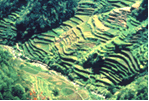 This picture shows a small part of the terraces, which extend over many square miles. We found a small rooming house in Banaue, and spent the night there. We were invited to attend a ceremony in a kiva in the barrio, so we climbed down into the small room that was to be part of the service. There were several men there, all smoking pipes, so it was indeed quite stuffy. Also, the talk was all in the local dialect so we had no real idea about what was going on.
This picture shows a small part of the terraces, which extend over many square miles. We found a small rooming house in Banaue, and spent the night there. We were invited to attend a ceremony in a kiva in the barrio, so we climbed down into the small room that was to be part of the service. There were several men there, all smoking pipes, so it was indeed quite stuffy. Also, the talk was all in the local dialect so we had no real idea about what was going on.
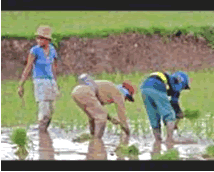 About 25-30% of the terraces are now abandoned, which has led to damage to some of the walls. This has arisen because parts of the irrigation system have been neglected, which in turn is due to people leaving the area. The situation is also aggravated by the effects of pest species of worms and snails; Despite good planning, irregular development is taking place, which threatens to erode the heritage landscape. Thus, this important heritage site is in danger of being lost.
About 25-30% of the terraces are now abandoned, which has led to damage to some of the walls. This has arisen because parts of the irrigation system have been neglected, which in turn is due to people leaving the area. The situation is also aggravated by the effects of pest species of worms and snails; Despite good planning, irregular development is taking place, which threatens to erode the heritage landscape. Thus, this important heritage site is in danger of being lost.
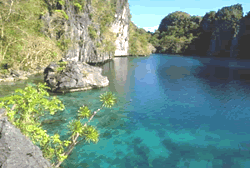 Another time we decided to check out the island of Palawan. This island is quite remote from the rest of the Philippines, being quite far to the west. We flew out there and landed at the capital city Puerto Princesa. We found a place to stay at a Hyatt Hotel. But, this was many years ago, so no ‘touristy’ accommodations were set up for us. Instead we made our way to the beach and surveyed the possibilities. A host of young Japanese tourists arrived at the same time, so we toured the area together. We found a couple of bancas and made arrangements for a couple hour tour along the shore. The scenery was magnificent, as you can see from the above picture. We visited the famous Princess St Paul Underground River Cave and were just overwhelmed by the beauty and quiet. This was all done some 40 years ago, and all has changed. There are now many resorts on the outlying islands, and no longer the feeling of being isolated.
Another time we decided to check out the island of Palawan. This island is quite remote from the rest of the Philippines, being quite far to the west. We flew out there and landed at the capital city Puerto Princesa. We found a place to stay at a Hyatt Hotel. But, this was many years ago, so no ‘touristy’ accommodations were set up for us. Instead we made our way to the beach and surveyed the possibilities. A host of young Japanese tourists arrived at the same time, so we toured the area together. We found a couple of bancas and made arrangements for a couple hour tour along the shore. The scenery was magnificent, as you can see from the above picture. We visited the famous Princess St Paul Underground River Cave and were just overwhelmed by the beauty and quiet. This was all done some 40 years ago, and all has changed. There are now many resorts on the outlying islands, and no longer the feeling of being isolated.
As time went on we left Cebu in June of 1968. However, I hope you appreciate how much happened outside of the Philippines during that time, and how it affected us. The first major event was the speech by President Johnson that he would not seek reelection. Johnson did many strong things about the elimination of segregation and racial prejudice, and really messed things up with Vietnam. He made his speech in March of that year, and took everyone by surprise.
Martin Luther King was killed by a sniper on April 4, 1968, at 6:01 p.m. as he stepped onto the balcony outside the Motel Lorraine in Memphis, Tennessee. In the Philippines this was 6:01 a.m. on April 5, 1968. I had been asked to be the emcee at the graduation ceremonies on that day at the University of San Carlos. I was having breakfast at a local restaurant, and at that time someone came and told me about this terrible event. The shock was enormous, and my filipino friends wanted to know from me what caused this horrible event. We talked about it at some length, and shared our feelings. The Commencement exercises were finally finished and I could go home with Sally and try to recover.
On June 5th, 1968, at 12:15am, Senator Robert F. Kennedy was making his way from the ballroom at the Ambassador Hotel, Los Angeles, to give a press conference, after winning the California Primary. While making his way through the kitchen area, a Palestinian Arab, Sirhan Sirhan, stepped forward and fired a .22 revolver at the Senator. This was at 12:15 p.m. the same day, in the Philippines. I was teaching a class in the main building of USC at that time, and someone came to the door of the classroom to tell me about it. I again was almost floored by the event, and after a break where I attempted to gather my thoughts I went back to the class to talk with them about it.
Within the next several days we left the Philippines for the long trip home. I had rearranged the tickets for the 5 of us so that we could finish going around the world instead of just flying back to Syracuse. When we returned home we had some communication from SEATO. It turned out that the sponsor of this trip was not at all happy with this action of mine. The tickets were for 1st class accommodations, and I traded them for coach class so that we could go see some more of the world. SEATO wanted their people to fly 1st class.
[1] http://www.jacobsmeyer.com/The_Search_for_Lapu_Lapu.htm
Now that I had changed the tickets from First Class we could reroute our trip home by continuing a westward thrust. So off we went one fine June day.
We flew first to Athens, after a refueling stop in Kuwait. It was early in the morning that we stopped in Kuwait, but nevertheless we left the plane to check out what this new country was like. We didn’t learn much, since all we could visit was the international waiting lounge, and once you’ve seen one of these you’ve seen them all.
We landed in Athens in the daylight and were just shocked with how bright everything seemed. It appeared as though every building was built with marble and the reflected heat and light was overwhelming.
We did all the touristy things that are expected of newcomers. Of course we went to what is on the hill in Athens, the hill known as the Acropolis.
I could not imagine passing up an opportunity like that.
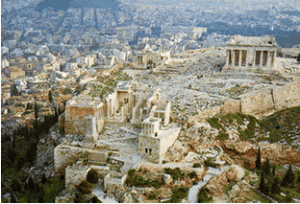 The Parthenon, one of the most beautiful structures to be seen dominates the Acropolis. We were intrigued by the information that the columns of the Parthenon are slightly out of line so that when the Parthenon is viewed from the Pynx against the blue sky, then they appear to be vertical. The above picture attempts to show that. (The Pynx is another hill in Athens.) On the north slope of the Acropolis is another building. This is the Erechteion.
The Parthenon, one of the most beautiful structures to be seen dominates the Acropolis. We were intrigued by the information that the columns of the Parthenon are slightly out of line so that when the Parthenon is viewed from the Pynx against the blue sky, then they appear to be vertical. The above picture attempts to show that. (The Pynx is another hill in Athens.) On the north slope of the Acropolis is another building. This is the Erechteion.
 The next picture shows this building. The roof of the building is supported by a number of statues of Greek maidens. But one is missing. That statue was looted by Lord Elgin, along with an enormous amount of other marble work, in 1801. The entire lot of the marbles he looted is known as the Elgin Marbles, and they all finally ended up in the British Museum in London. The reason I mention all this is because a few weeks later we were in London, and visited the British Museum. As we were prowling through it Mark suddenly yelled: “there’s the missing statue!” Indeed off to one side was that particular Elgin Marble. Sally & I were thrilled that Mark remembered that incident back in Athens.
The next picture shows this building. The roof of the building is supported by a number of statues of Greek maidens. But one is missing. That statue was looted by Lord Elgin, along with an enormous amount of other marble work, in 1801. The entire lot of the marbles he looted is known as the Elgin Marbles, and they all finally ended up in the British Museum in London. The reason I mention all this is because a few weeks later we were in London, and visited the British Museum. As we were prowling through it Mark suddenly yelled: “there’s the missing statue!” Indeed off to one side was that particular Elgin Marble. Sally & I were thrilled that Mark remembered that incident back in Athens.
We roamed around Athens for a few days, seeing the sights. One place we went was Omonia square. The squared was surrounded with small shops selling food, collectibles, and just about anything of value. The food was sold in shops that had large pieces of meat on skewers. The attendant would carve off a huge slice, and serve it with appropriate breads and gravies. I particularly liked the lamb.
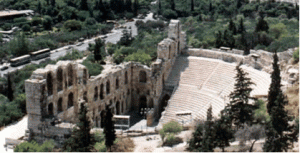 We found the remains of an old theater, shown in this picture. This is the Odeon of Herodes Atticus. The acoustics are amazing – a sound on the stage could easily be heard throughout the structure.
We found the remains of an old theater, shown in this picture. This is the Odeon of Herodes Atticus. The acoustics are amazing – a sound on the stage could easily be heard throughout the structure.
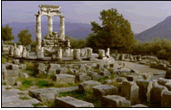 In order to figure out our future we decided to take a bus trip up to the Oracle at Delphi. The stories around this site and how it all figured into the politics, and economics, of the time are fascinating. Briefly, the Oracle was quite good at making economic predictions because so many merchants came to the Oracle for predictions. Well, they might have come for predictions but they also unwittingly gave a lot of information about their home countries, their products, and where they were headed. So, this is what is left of the Oracle, and it was fascinating to walk around the grounds and think back upon all the events that had occurred here over the centuries.
In order to figure out our future we decided to take a bus trip up to the Oracle at Delphi. The stories around this site and how it all figured into the politics, and economics, of the time are fascinating. Briefly, the Oracle was quite good at making economic predictions because so many merchants came to the Oracle for predictions. Well, they might have come for predictions but they also unwittingly gave a lot of information about their home countries, their products, and where they were headed. So, this is what is left of the Oracle, and it was fascinating to walk around the grounds and think back upon all the events that had occurred here over the centuries.
When we were through in Athens we flew on to Munich, Germany. This city is rich in the history of the time of the rise of Nazis and the Third Reich. We stayed in a hotel in the middle of Munich near the famous Hofbrau Haus. I suppose we walked some of the same places that Adolph Hitler did. The Hofbrau Haus was fascinating to visit, especially to watch the waitresses carry about a dozen steins of beer, in one load, to the thirsty customers. The music was great, the rooms crowded, and a lot of conversation and singing went on.
One of the reasons we came to Munich was to visit Dachau, a former concentration camp near to Munich. So we rented a car and drove there. It is difficult to state all the feelings and sights of that place. The frightening ovens were still standing, and in horror we inspected them. I could almost hear the groans of the bodies as they were incinerated. One of the features of the concentration camp was that it was ringed with poplar trees. This was in 1968, so the camp had been occupied 23 years ago when the trees were newly planted. This drove home to me the realization that all of the horrors had just recently occurred.
There was a building inside the camp which was used for religious services– I don’t know if it qualified as a temple. It was entered by way of a ramp down to the main altar. On one side of the camp there was a frieze of human figures that had the appearance of being skeletons. Above them, in several languages, were the words “Never Again”. Of course there was a building housing memorabilia of the days in which the concentration camp was in use. There were many pictures and samples of writing that some of the victims had succeeded in making. In all one got the feeling that the place had been cleaned up and put in order.
Some years later, in April 2004, Dolores and I had the opportunity to visit Auschwitz, which is just outside Krakov, Poland. The contrast with Dachau is enormous. In Auschwitz one could see the physical remains of many of the victims – clothing, shoes and hair. Auschwitz looks like it was left in the condition it was in at the time of release of the prisoners. Dachau looks like it was cleaned up for the tourists. Dachau is in Germany, the country that initiated the holocaust. Auschwitz is in Poland, the country that was invaded by the Nazis and started World War II in September 1939.
We drove back to Munich with a lot to think about.
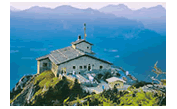 Our next excursion took us east from Munich. We decided to drive to Berchtesgaden, the location of Hitler’s Eagle’s Nest. The drive was again momentous as the mountains in the area are so beautiful and we took the time to walk along the sides of them. We drove up the mountain to the Eagle’s Nest, and were able to tour the inner buildings and again get the feeling of those times. On to Salzburg for a look at that city and that completed this side excursion.
Our next excursion took us east from Munich. We decided to drive to Berchtesgaden, the location of Hitler’s Eagle’s Nest. The drive was again momentous as the mountains in the area are so beautiful and we took the time to walk along the sides of them. We drove up the mountain to the Eagle’s Nest, and were able to tour the inner buildings and again get the feeling of those times. On to Salzburg for a look at that city and that completed this side excursion.
The hotel we were staying at in Munich was quite expensive, and one day at breakfast we were discussing the possibility of moving to a less expensive place, like a bed and breakfast. There was a man sitting at a nearby table and he overheard our discussion. He excused himself for listening but said he could offer us some help. It turned out that he had been a soldier in the German army, and after he had been captured he spent sometime in an American prisoner of war camp. We talked about his experiences, but whatever they were he bore no animosity towards Americans.
We decided we would like to see more of Europe and so went driving through Liechtenstein. Not much to report here, since we drove through on a Sunday, and the one castle we wanted to visit was closed. We also drove to Chur, Switzerland to spend a couple of nights looking at this country. I remember we walked outside our hotel late one evening and just wandered through Chur. On the way we met a man pushing a cart with some foodstuffs on it- a lonely figure on a quiet street. Everything was so quiet and peaceful. It still is sharp in my memory. It was here that we encountered snow for the first time in a couple of years. We were high in the Alps, and snow was on the ground even though it was mid summer. Jim, Mark and Nannette had a very busy snowball battle to celebrate the time.
The next place we visited was Frankfurt, Germany. We went there because we wanted to sample some of the apple wines, and look at all the sidewalk statues. It seemed there were fountains everywhere, and most of them were spouting water. Some of them were little boy statues and were used to the fullest extent. I don’t know if there were people watching us, but often we would be sprayed as we walked by one of those statues.
Frankfurt is near to the Rhine River, so we bussed over to Weisbaden and took a boat ride down the Rhine to look at all the castles. That is a wonderful way to be a tourist. We then got onto an overhead cab and rode across extensive grape fields. At the far end there was a small town and they were having a band festival. I just love German band music, and we stayed in that village as long as we could.
Our weeks in Europe were coming to a close, so we headed for London, the next city on our list. We flew there from Frankfort, and stayed in a hotel at Piccadilly Circus. We were overwhelmed by all the activity – bustling traffic, street performers, and noise everywhere. It was a short walk to Trafalgar Square, and Jim was particularly thrilled that we were close to Carnaby Street. He had been looking forward to this visit since we first planned the trip, and we all went to Carnaby Street to help him buy a modern suit.
Paul Fawcett was born and raised in Halifax, England, and we had talked with him about visiting his parents while we were in England. So we rented a car and motored our way up to Halifax, Yorkshire. When we told people in London what our plans were they first thought we were talking about Halifax, Nova Scotia. When we corrected that then they just could not understand why anyone would go the
But we went anyway, and met Paul’s family. His younger brother decided he would show us all the various kinds of pubs in this fair city. We started with a neighborhood pub where Paul’s parents would go, and it was deadly. After 5 minutes there we moved on to another pub, with much the same effect. Finally his brother took us to the pub that he frequented, and that was somewhat livelier. But I bought a pint in each pub and when I left this last one I had a little difficulty forcing myself to drive on the left. So, that was the clue it was time to quit and go back to our hotel.
Our route back to our hotel passed near to Nottingham and we decided it would be great to go on a hunt for Sherwood Forest. Maybe we would see Robin Hood or one of his merrie men. It was a cloudy and rainy day so our search was rather abbreviated. Suffice it to say Robin Hood’s hiding place remained secure from our searching.
Once back in London we felt it was necessary to explore more of the city and some of the sights. Trafalgar Square was nearby and we walked there to view the pigeons and the people and were not disappointed in either. On the way we watched several different street displays – magicians, sleight of hand, dancers, and the like just added a great life to the area.
At one point the five of us went into a large department store to compare prices and products as we roamed through it. We left after several minutes of this and continued on our way to Buckingham Palace and the changing of the guard. We had gone a good block or so before we looked around for Mark – he was missing! The street was crowded and we had crossed an intersection and raced back towards the store with panic tearing at us. How would we ever find him in this city? Due to his excellent upbringing we were able to find him very quickly. We had warned him to never cross the street without one of us, and there he was, standing at the end of a block waiting for us! He told us that some people had offered to escort him across the street, but he decided he would wait there for us.
We continued on our way to the Palace and then to St. James square to stare at the guard in his little guard house. He indeed seemed to completely ignore us in spite of Nannette’s gyrations in front of him.
Finally along came a Sunday, that last day in London. We were to leave early in the morning the next day to fly back to Syracuse, and we decided to rest a little bit. Suddenly I realized that we had not seen the London Bridge! I said to them: “There is one more thing we must do. We cannot leave London without seeing the bridge!” My announcement was met with utter scorn and a couple of unflattering remarks. Fortunately the London Bridge was later purchased by Havasu City in Arizona, so if we ever want to see it, we do not have to make an international case of it.
